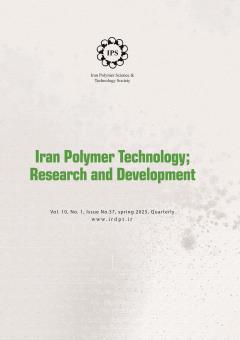تبیین جدایش فازی گرانروکشسان در سامانه های پلیمری
الموضوعات :
1 - دانشگاه صنعتی مالک اشتر
الکلمات المفتاحية: جدایش فازی گرانروکشسان, عدم تقارن دینامیکی, محلول های پلیمری, آلیاژهای پلیمری, رئولوژی,
ملخص المقالة :
در راستای درک بهتر جدایش فازی به عنوان پدیده ای اساسی در ایجاد و کنترل الگوهای ناهمگن فضایی در سامانه های پلیمری، استدلال شد که جدایش فازی در این سامانه ها به طور کلی از نوع "جدایش فازی ویسکوالاستیک" است، که در آن مورفولوژی سامانه نه تنها تحت تأثیر تعادل مکانیکی نیروی ترمودینامیکی، بلکه از نیروی ویسکوالاستیک نیز تأثیر می پذیرد. منشأ نیروی ویسکوالاستیک، عدم تقارن دینامیکی بین اجزای مخلوط پلیمری است که می تواند ناشی از اختلاف اندازه یا تفاوت در دمای انتقال شیشه بین اجزا باشد. این عدم تقارن دینامیکی اغلب در محلول ها و آلیاژهای پلیمری وجود دارد و به طور کلی منجر به یک مسیر جنبشی جدید تحت عنوان حالت ژل گذرا، پس از جدایش فازی می گردد. ژل گذرا حالتی است که در آن نرخ تغییر شکل مشخصه تولید شده توسط جدایش فازی سریعتر از نرخ آسودگی رئولوژیکی مشخصه است. ویژگیهای اساسی جدایش فازی ویسکوالاستیک، که از تشکیل ژل گذرا نشأت میگیرد، تقریباً در اغلب سیالات "نامتقارن دینامیکی" که اختلاف اندازه زیادی بین اجزای تشکیل دهنده دارد، مانند محلولهای پلیمری، مشترک پیش بینی شد. بعلاوه، تکامل الگوی ساختاری در محلولهای پلیمری و آلیاژهای پلیمری در اصل مشابه بوده و هیچ اختلاف کیفی بین این دو حالت وجود ندارد که این موضوع ماهیتی جامع از جدایش فازی ویسکوالاستیک در مخلوط های نامتقارن دینامیکی صرف نظر از منشأ عدم تقارن را پیشنهاد می کند.
[1] A. Onuki, Phase transition dynamics, Cambridge University Press, 2002.
[2] L. Utracki, B. Favis, Polymer alloys and blends, Marcel Dekker: New York, 1989.
[3] H. Tanaka, Universality of viscoelastic phase separation in dynamically asymmetric fluid mixtures, Physical review letters 76(5) (1996) 787.
[4] K. Yoshimoto, T. Taniguchi, Viscoelastic phase separation model for ternary polymer solutions, The Journal of chemical physics 154(10) (2021).
[5] A. Brunk, B. Dünweg, H. Egger, O. Habrich, M. Lukáčová-Medvid'ová, D. Spiller, Analysis of a viscoelastic phase separation model, Journal of Physics: Condensed Matter 33(23) (2021) 234002.
[6] S. Ge, S. Samanta, B. Li, G.P. Carden, P.-F. Cao, A.P. Sokolov, Unravelling the mechanism of viscoelasticity in polymers with phase-separated dynamic bonds, ACS nano 16(3) (2022) 4746-4755.
[7] A. Surendran, J. Joy, J. Parameswaranpillai, S. Anas, S. Thomas, An overview of viscoelastic phase separation in epoxy based blends, Soft Matter 16(14) (2020) 3363-3377.
[8] H. Tanaka, Critical dynamics and phase separation kinetics in dynamically asymmetric binary fluids: New dynamic universality class for polymer mixtures or dynamic crossover?, The Journal of chemical physics 100(7) (1994) 5323-5337.
[9] H. Tanaka, Y. Nakanishi, N. Takubo, Nonuniversal nature of dynamic critical anomaly in polymer solutions, Physical Review E 65(2) (2002) 021802.
[10] A. Kostko, M. Anisimov, J. Sengers, Dynamic crossover to tricriticality and anomalous slowdown of critical fluctuations by entanglements in polymer solutions, Physical Review E 66(2) (2002) 020803.
[11] A. Furukawa, Viscoelastic effect on hydrodynamic relaxation in polymer solutions, Journal of the Physical Society of Japan 72(2) (2003) 209-212.
[12] A. Furukawa, Dynamic critical phenomena of polymer solutions, Journal of the Physical Society of Japan 72(6) (2003) 1436-1445.
[13] H. Tanaka, T. Araki, Viscoelastic phase separation in soft matter: Numerical-simulation study on its physical mechanism, Chemical engineering science 61(7) (2006) 2108-2141.
[14] H. Tanaka, Unusual phase separation in a polymer solution caused by asymmetric molecular dynamics, Physical review letters 71(19) (1993) 3158.
[15] H. Tanaka, Viscoelastic model of phase separation, Physical Review E 56(4) (1997) 4451.
[16] H. Tanaka, Viscoelastic phase separation, Journal of Physics: Condensed Matter 12(15) (2000) R207.
[17] H. Tanaka, Viscoelastic phase separation in soft matter and foods, Faraday discussions 158(1) (2012) 371-406.
[18] H. Tanaka, Viscoelastic model of phase separation in colloidal suspensions and emulsions, Physical Review E 59(6) (1999) 6842.
[19] H.R. Heydarnezhad, N. Mohammadi, A. Arbe, A. Alegria, How does microstructural design affect the dynamics and rheology of segmented polyurethanes?, Macromolecules 53(13) (2020) 5381-5398.
[20] H.R. Heydarnezhad, N. Mohammadi, A. Alegria, Non-Einstein rheology in segmented polyurethane nanocomposites, Macromolecules 54(6) (2021) 2783-2796.
[21] J. Jackle, M. Pieroth, Theory of structural evolution in viscoelastic binary liquid mixtures after a temperature jump, Zeitschrift Physik B Condensed Matter 72(1) (1988) 25-39.
[22] D. Sappelt, J. Jackle, Spinodal decomposition with formation of a glassy phase, EPL (Europhysics Letters) 37(1) (1997) 13.
[23] D. Sappelt, J. Jackle, Computer simulation study of phase separation in a binary mixture with a glass-forming component, Physica A: Statistical Mechanics and its Applications 240(3) (1997) 453-479.
[24] D. Sappelt, J. Jackle, Percolation inversion in spinodal decomposition of mixtures with strong kinetic asymmetry, Polymer 39(21) (1998) 5253-5256.
[25] P. De Gennes, Dynamics of entangled polymer solutions. I. The Rouse model, Macromolecules 9(4) (1976) 587-593.
[26] P. De Gennes, Dynamics of entangled polymer solutions. II. Inclusion of hydrodynamic interactions, Macromolecules 9(4) (1976) 594-598.
[27] F. Brochard, P. De Gennes, Dynamical scaling for polymers in theta solvents, Macromolecules 10(5) (1977) 1157-1161.
[28] A. Onuki, Elastic effects in the phase transition of polymer solutions under shear flow, Physical review letters 62(21) (1989) 2472.
[29] A. Onuki, Phase transitions of fluids in shear flow, Journal of Physics: Condensed Matter 9(29) (1997) 6119.
[30] M. Doi, A. Onuki, Dynamic coupling between stress and composition in polymer solutions and blends, Journal de Physique II 2(8) (1992) 1631-1656.


